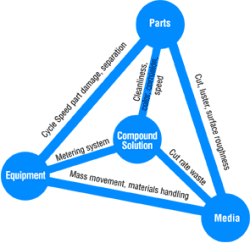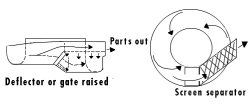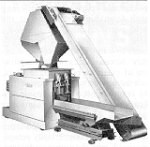Understanding Vibratory Finishing: Part 3 of 4: Media
The relationship of media, compound solutions, equipment and parts in successful vibratory finishing. how to improve your troubleshooting...
#basics
This series of articles deals with four interdependent elements of the vibratory finishing process: media, compound solution, equipment and parts. Fig. 1 shows the "Tetrahedron of Interdependence," a way to indicate that these four elements of a vibratory finishing process are so dependent on each other that a failure of any one causes the entire process to fail. Parts 1 and 2 dealt with media and the compound solution, respectively. Part 3 deals with equipment.
Basically, these are the functions of equipment:
Featured Content
- Process parts.
- Permit or effect separation.
- Control mass action.
- Meter compound solutions.
- Provide design integrity.
- Provide adequate controls.
- Provide needed automation and systemization.
- Comply with safety requirements.
A rather important container, at that!
Process parts
Obviously, the equipment must do the deburring, cleaning, surface conditioning, burnishing or whatever may be required. These are requirements for individual parts and will be dealt with in more detail in Part 4.
Separation
If you mix 'em, you've just gotta separate 'em! By definition, manufacturers of "mass" finishing equipment deal with this problem on a regular basis or they wouldn't still be in business. Separation skills are therefore high on the normal capability list. Even so, severe problems will still arise, because (a) not enough thought went into the problem in the first place, (b) the equipment supplier never saw those darned parts, or (c) these parts and media are impossible to separate.
The simplest separators are screens. Woven wire is the cheapest screen and the most common. Cast polyurethane, plastisol-coated wire and similar types are also popular.
These "protected" types reduce noise and can be used to protect soft metals from the high amplitude of the separation deck. Perforated metal and plastic sheets are flatter and allow parts to slide over them more easily. For parts with "legs" or other projections that would cause their hang up in the screen, the tie rod deck is a good choice. More expensive to build, it allows parts to slide down parallel rods while the media drops through. The rods can be steel rods or bars, inverted angles, steel-reinforced cast polyurethane or plastic bars. They should always be straight and have parallel sides.
When parts are small--smaller even than the media--think of inverse separating decks. These retain the media on the screen or tie rods and allow the parts to drop through. Tricky design, but effective.
Constant or periodic media classification can be done on triple-level decks. Lodging is then never a worry. These decks can be all screen, all tie rod or combinations, regular or inverse.
Other decks can turn parts over, provide independent amplitude control and reduce noise with covers. Or they can be a part of a fresh water or inhibitor rinse area.
Control mass action
To be of use to us today and also to serve our needs for the parts of tommorrow, the equipment must have adjustments so that more aggressive or more gentle work can be done. Vibratory machines are normally so equipped.
Tub-type vibratory equipment has a variable-weight system to adjust energy input. Generally there is a single shaft mounted directly underneath the tub. On each end of this shaft is an eccentric weight which has some variability in its mass. More weight, more amplitude, faster cutting, rougher surfaces, greater media wear. Fig. 2 depicts the tub vibrator in its various modes: loading, processing and unloading.
The speed of rotation of the eccentric weights is another variable. Higher speed generally promotes faster cut, rougher surfaces and greater media wear rates.
In round vibratory equipment, the eccentric weights are mounted on each end of a vertical shaft or motor in the center tube of the tub The amount of weight on the top eccentric generally controls the speed of mass travel around the tub, while the amount on the bottom controls the roll-over rate of the mass. The relative position between the two controls both the roll and feed. The eccentric weights rotate in a direction opposite to that of the direction of mass travel.
In Fig. 3 is a simplified weight system for the round type of vibrator. This type has no elevation or rise in the tub chamber and is perfectly symmetrical in design. Parts are loaded over the top of the machine and unloading is either by hand picking or media and parts discharge out through a door in the tub wall.
Fig. 4 shows the round type of machine with the elevation in the tub to assist separation. It is equipped with a built-in screen deck and deflector to control direction of mass flow. In the dotted position, the deflector allows media and parts to pass over it and proceed around the tub. At the end of the cycle, the deflector is elevated and the mass directed up onto the screen separator. The deflector can be as shown, as a separate blade inserted at the end of the cycle, like the rudder of a boat, or it may be designed in other ways. The principle is the same.
Generally speaking, the round vibrators are better in mixing media and parts than the tub types. They don't exhibit the "end effect, " wherein segregation of parts and media can sometimes occur. Solution flow or distribution is also not as critical in the round machines.
Meter compound solution
Control of the flow rates of water and compound makes it possible to vary the concentration of compound. These metering systems should be consistent and dependable, economical, provide required automation, and be simple to operate and maintain. Requirements for these systems are as follows.
Flow rate of compound and water. In order to get uniform, predictable results, you must provide uniform flow of solution. Certain processes, such as those using steel media, or when the primary purpose is cleaning, require even more accurate controls of the solution flow.
In some plants, water pressure varies considerably. It falls when toilets are flushed or if cooling water is turned on. In these plants, water pressure to the compound feed system may have to be controlled separately. Uniform water pressure is absolutely necessary.
Solution concentration. In Part 2, we showed why certain minimum solution concentrations have to be maintained. Below the threshold levels, poor results are bound to occur. Too high a concentration is wasteful. Accurate control therefore saves money.
Consistency, dependability. There's nothing much worse than a new vibratory system that costs $20,000 to $100,000, with horrendous operating problems that are finally traced to a faulty compound pump. The pump probably costs only $500. The flow rates needed today are going to be needed two, six and 26 months from now. Flow rate changes from any cause must be avoided. Economy. If the metering system is accurate, it will be economical as well. This is the only way that will not waste compound! In addition, automatic systems don't waste labor.
Automation. For hundreds of applications, manual compound systems are completely satisfactory. But fully automatic types should be considered. The automatics can even ring a bell or light a light to signal the operator when the drum of concentrate is getting low.
Simplicity. The old KIS ("Keep It Simple") principle applies to mass finishing as easily as to so many other things in life. With less to go wrong, there is greater reliability.
Design integrity
A vibratory machine is uniquely designed to self-destruct, if and when the opportunity presents itself. Anything that shakes with the fury of these devices is prone to destroy itself. Light-weight construction is therefore not a reasonable concept if it sacrifices structural integrity in any way. When you've witnessed the awesome power of big vibratory machines in this destructive mode, the message is quite clear.
Perhaps the most important rule for maintenance of vibrators is to keep everything tight. When anything is loose, rebolt or reweld or take it off. It is much more expensive to repair later.
Controls
Electrical designs can be interlocked so that all controls of even the most complex system are in the same panel. Safety considerations dictate that start-up should not thing that be possible when someone is adjusting weights. Integrated solution systems start and stop with the machine. Separate plug-in devices have run out more than one drum of compound overnight! Have emergency stops. Use timers for the process, for separation and for parts loading. Consider systems sequencing, and so on.
Automation/systemization. By far the greatest number of vibratory "systems" now in use consist of a simple machine and little else. Some large manufacturers, however, are running large tonnages of industrial parts through complex, integrated systems. Why? Simply because it's cheaper. Why batch handle parts when they can be deburred and cleaned in a single, continuous process?
Users of vibratory finishers should at least consider where they might be able to use systems concepts, even if these methods can't be used right away. Vibratory processes can be automated and integrated into other plant systems to any degree desired.
Safety
When properly designed, vibratory equipment is completely safe to operate. Never "save time" by removing safety devices! Don't remove noise covers to speed up loading and unloading. The increased noise not only is harmful to hearing but affects performance of workers in the area subtly and persistently. Worker output declines. The "savings" really cost more.
Equipment and Media
Materials handling. "Mass movement" and "Materials handling" are the two effects between these two. Movement of the mass has been discussed above and in Part I. By definition, a "mass" finishing process occasionally has to involve considerable masses.
The time required for separation was discussed in Part I and the loss of only five min per cycle was shown as an important consideration.
Consider the vast weight of media. Consider a 20-cu-ft (566 liter) vibrator operating with ceramic media on a continuous 15-min cycle, using 20 x 100 or 2,000 lb (907 kg) of media per cycle.
- 4 cycles/hr = 8,000 lb (3,630 kg) pe, hr
- 8 hr/day = 64,000 lb (29,030 kg) per day
- 5 days/week = 320,000 lb (145,000 kg) per week 50 weeks/yr = 16,000,000 lb (7,257,000 kg) per yr
Now moving those tons with a shovel will develop a very tired back! Of course, if you have plastic media, you're only dealing with 10,000,000 lb (4,500,000 kg) per year, but on the other hand, steel media makes it 48,000,000 lb (21,800,000 kg). Wow! Anything you can do to move that weight mechanically is worth considering.
Equipment and Parts
The tetrahedron tells us that equipment and parts affect "cycle speed, part damage and separation." Speed is a function of machine settings and has been covered.
Part damage can occur during materials handling as well as inside the machine. Damage often occurs when parts are loaded into the machine. So be sure all parts are not dumped in together. Otherwise they can damage each other before being separated by media. This is a great place to ruin preplate surfaces so that the process has no chance of removing these new defects.
Damage can also take place during the process. For example, long parts can tangle, or, if one of them stops, the others catch up and a "log jam" develops. Parts can catch in drains, and then damage and be damaged by other parts.
Separation is another likely place to damage parts. Damage may result from high amplitude of the deck, parts catching on the deck, parts stopping for a moment for others to bump into them, etc. Auxiliary screen decks effect separation of even the most fragile parts, such as powdered and pressed ferrite components for electronic applications. These parts are almost as fragile as popcorn, but can be deburred easily and separated from media at good, commercially acceptable speeds with the proper equipment.
Fig. 5 shows a tub-type vibratory finisher with auxiliary materials handling. It has an 18-cu-ft (500 liter) tub, lined with polyurethane elastomer, and constant compound spray, with bottom drain. An oversized discharge door is operated by two air cylinders. Parts and media flow from this door onto the double-deck oscillating screener. It separates media from parts and removes undersized media fines.
Media is elevated and returned to the two-compartment storage hopper via the inclined conveyor. The system can handle small batches of parts or large machined parts. The latter are individually unloade.1 from the operating machine. Speed is variable—from 875 to 2,100 vibrations per min with a 1 5-hp drive motor.
Fig. 6 shows a series of round tubs with a common, external separation deck. When parts are too similar in dimension to make internal separation practical, external separation is a good choice. The savings in using a single separation device for a number of tubs are evident.
A fully continuous round vibratory machine is shown in Fig. 7. The stack loader in front meters parts to the conveyor belt, which feeds the load chute in the vibrator. Parts progress around the tub in a counterclockwise direction, slowly and uniformly. They separate from media on the built-in screen deck, proceed under a rinse station and on into the recirculating hot-air dryer.
Equipment and People
Most equipment manufacturers try to design equipment to minimize the influence of people. When successful, this makes the process more uniform and causes less variation in results. The system is easier to operate and, consequently, more "goof-proof. "
We must always remind ourselves that people make the changes, not the process! People change media compound, speed, parts load, flow rates and anything else that isn't nailed down. To overcome this problem, many companies lock the controls so that operators can't touch them. Then operators can't shortcut the successful cycle with the idea of improving incentive pay.
The variables designed into mass finishing equipment are there to provide versatility, not to let an operator tinker. They are there to permit more types of work to be done, not less. So, if your process works, do not tinker with the controls without having a good reason to do so! And never do so without having recorded all the conditions and settings that worked initially
Your new tool will pay handsome dividends if you provide timely maintenance, too. Consistent incoming parts (our next chapter) also are important.
RELATED CONTENT
-
Polishing vs. Buffing: What's the Difference?
Is polishing the same as buffing? Mechanical finishing expert, Pat Wenino, explains the differences between the two processes.
-
Nickel Electroplating
Applications, plating solutions, brighteners, good operating practices and troubleshooting.
-
Alkaline Cleaning Guide
Gregg Sanko, Senior Chemist, Oakite Products, Inc. provides an overview of the alkaline cleaning process.

























